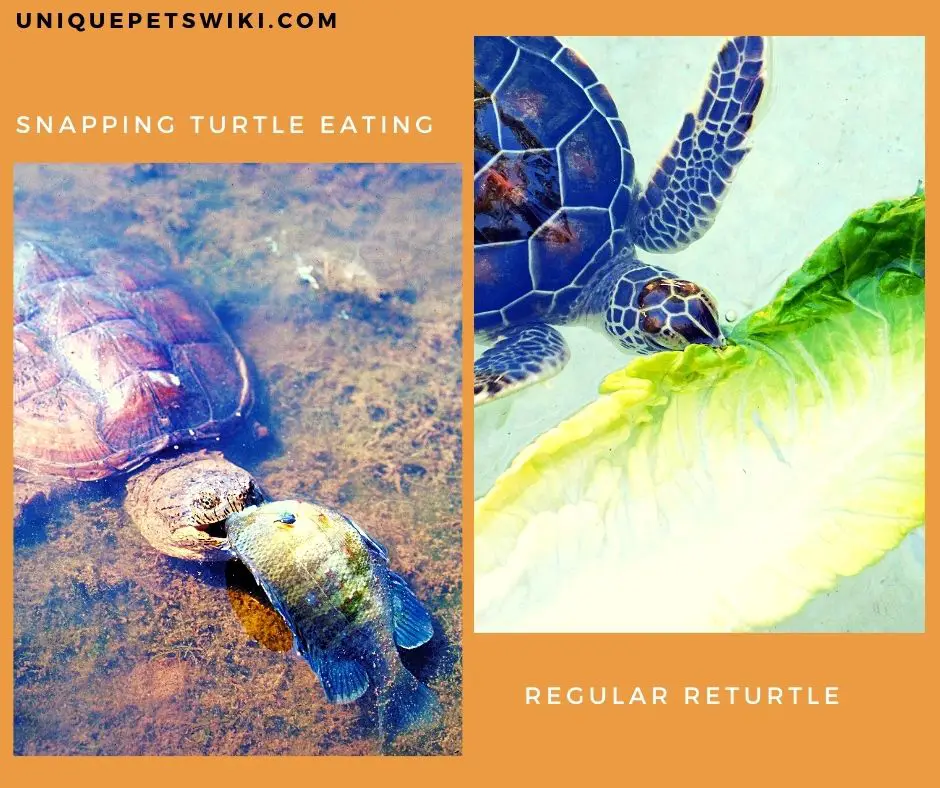Are you curious about the differences and similarities between a snapping turtle and a regular turtle? Planning to buy but still undecided? If yes, here you can read the full comparison of a snapping turtle and a regular turtle!
“There is always something more to learn. Even for a Master.”- Master Oogway of Kung Fu Panda
Contents
Snapping Turtle Vs Regular Turtle: Full comparison
Snapping Turtles are mostly aggressive in nature, have darker color, have higher chances of biting you back and are mostly larger than regular turtles.
Of course, the opposite would be regular turtles have milder and gentler nature, have brighter colors and are more likely to be recommended as a pet.
But hey, this doesn’t mean that snappers don’t deserve love! They just need more understanding and care, since they’re more aggressive (if you’re up to the challenge, go for it!)
Appearance
Regular turtles are mostly yellow, green, greenish-brown, olive, or black in color. Long and paddle-like are its forelimbs, and have larger upper lids. So they’re brighter-colored and almost as bright as their personalities!
In contrast, the snapping turtle’s skin is rough, they are web-footed and have firm claws. It’s upper shell is relatively smaller compared to other turtles and much of their body is exposed. Their color varies from brown to almost black.
So we can generally say that regular turtles are much more colorful than the snapping turtles and much more covered with its shell than the snapping turtles which are exposed.

Shape, Size, Weight
Snapping turtles can be identified by the saw-edged crest on the upper side of its tail and averages 20–30 cm (8–12 inches) in shell length and 4.5–16 kg in terms of weight. They’re usually oval shaped and have rough spikes on their shells.
While regular turtles have large, streamlined, and flat shells and non-retractable heads and limbs, most adults are 8 to 12 inches (20-30 cm) long.
So snapping turtles are definitely larger, heavier, and rounder and are actually faster to grow than the regular turtle. And yes, you are like holding a dumbbell if you lift an average snapping turtle!
Habitat
Regular turtles spend most of their time on water. They are adapted for aquatic life and Most of them can be found in North America and South Asia. But these are relative to the breed of the turtle itself.
Regular Turtles prefer freshwater ponds, and streams. Snapping turtles are living in almost any permanent freshwater body including ponds, lakes, rivers, creeks, backwater sloughs, and they are mostly seen in North America.
Both of them can be found in America and can live in bodies of water.

Growth Rate And Lifespan
Snapping turtles will reach maturity between 11 to 16 years and can make themselves live up to 40 years or more. While regular turtles can live between 10 and 80 years and will reach maturity at 5 to 8 years.
They have almost the same number of years of maturity and lifespan. So yeah! They can be much older than us and regular turtles are earlier to sexually mature compared to snapping turtles.
Predators
Snapping turtles are most vulnerable when they are newly hatched. In this situation they are being preyed upon by foxes, coyotes, skunks, minks, fishers, raccoons, crows, herons, hawks, owls, river otters, bullfrogs, fish and snakes.
Though snapping turtles are considered apex predators or those at the top of the food chain in the wild given their aggressive nature, and their tough shell make a dynamic duo.
Regular turtle’s predator include crabs, lizards, birds, raccoons, wild pigs, coyotes, dolphins, sharks and many species of carnivorous fish such as snapper, grouper and barracudas (this so to speak when they’re only hatchlings).
Both of them almost have the same predators and both are vulnerable during hatching or laying eggs.
Active level
“Hey dad, can I play with the turtles?” Sure you can, just keep in mind that Snapping Turtles are only active during the night when they’re out for hunting, and regular turtles are active during the day time, sweetie.
Yep, you guessed it, snapping turtles are nocturnal, though they can be seen swimming during the day. They rarely bask, preferring the safety of mud and weeds in the day (but of course they need dry land too, they’re no fish).
On the other hand, regular turtles are diurnal, spending their nights floating near the surface or tucked into a rock or coral crevice.
So you’ll either see floating shells during the night, or reptilian hunters instead. But during day time, you’’ most likely encounter sun-bathing turtles or stationary rocks that usually move during the night.
Personality And Defense Mechanisms
Turtle Power! If the Teenage Mutant Ninja Turtles use weapons to beat bad guys, then snapping turtles fight back by means of well, snapping their eagle-like beaks or attempting to slash you with their claws.
While the regular turtles prefer retracting their bodies inside their shell or casually going into the water to avoid danger. Though turtles emit a strong smell in attempts to fend off potential predators (I’m onto you turtles).
So remember, snapping turtles really bite back as their defense, and regular turtles just swim away or go home to their shells.
At least now you know that they have similarities in terms of defense mechanism (except ninja turtles of course).
Swimming/Run Ability And Speed
Known to man as slow, but did you know that Snapping Turtles have a running speed of 2.4mph and a swimming speed of 10 to 12mph which is surprising given their large size.
On the other hand, regular turtles have an average running speed of 3 to 4mph whenever they’re on land, but what’s really impressive is that they have swimming speed reaching 10 to 12mph with some species reaching around 20mph!
In this case, both snapping turtles and regular turtles are slow in land but fast in water. Just like Nemo’s father’s ride! This means that turtles can be champions in water racing competitions!
Regular turtles may be faster given their size when in comparison to snapping turtles which is why running to the water is one of their defense mechanisms. You thought that a turtle is slow isn’t it? (Maybe it is their secret, let’s just keep them.)
Diet
What’s for dinner? Well, we have different insects, worms, small fishes and mammals, frogs, spiders, and even carrion for lunch and dinner for Snapping turtles, since they’re not picky eaters and are generally omnivorous.
Adult regular turtles are not picky eaters either. They practically share the same diet as snapping turtles but they generally feed more on plants, and vegetation rather than animals. Turtles between the age of 7-10 years old need more animal-based food.
See the similarities? They are both omnivores, so now at least you know what amount and kind of food you need to give to your future turtle pet.

Brumation
Ah, winter is coming. The time of sleeping or slowing metabolic processes for turtles (Brumation). Some Snapping Turtles do not undergo Brumation since they have extremely high tolerance to the cold.
Regular turtles, on the other hand, practice brumation. They burrow themselves, under the mud of swamps, and bottom of marshes to slow down their metabolic processes and breath through their butts (also known as cloacal respiration).
Through this, both turtles can get sufficient oxygen for their needs without using their lungs. Given the cold temperature, this is their version of hibernating and depending on their stored fat.
Mating
Prominently active in the summer months, especially from April to November, that’s when mating season starts for Snapping Turtles. On the other hand, Regular Female turtles are mostly active during March to June making summertime, mating time.
The mating starts when male turtle faces the other and vibrates or shakes their frontal claws around the female turtle’s head. To which the female reciprocates and mating starts when the female swims underwater.
Regular male turtles start courtship after sexual maturity of 4-6 years which they perform with their flippers waving back and forth to get a female turtle’s attention. Regular female turtles shake their heads and eventually swim underwater to start the mating process.
Fun fact: Both turtles usually take 10-15 minutes to finish mating wherein the female turtle can store turtle semen for 3 years and continue laying eggs.
Before you breed turtles, make sure that they are ready and on condition, not following these two may cause a problem or bad ending. Do not try cross-breeding as this can result in the death of the female turtle.
Reproduction
Female Snapping Turtles often choose the best nesting site that is an area of loose soil, loam, or sawdust where it burrows around 4-8 inches deep and lay around 20 eggs that is the size of ping pong balls.
For regular female turtles, broad sunlight is what they look for. They usually lay their eggs in sandy areas such as beaches where they hatch after 60 to 80 days depending on the exposure, and temperature the eggs receive.
Turtle nesting sites can be seen on land, and are typically can be found on the beach’s sand. If you love travelling on the beaches around the world, you may have a chance to see a group of egg shells.

Required Take Care
Ever dreamed of having your own man-cave? Or perhaps your own spa? Well the turtles do too! So here, are certain requirements for them to remain healthy, and happy. You know what they say, a happy turtle, is your best friend.
Enclosure Size
Maintain a 20-30-gallon tank for both Snapping and Regular Turtle Hatchlings that is around 4-6 inches. Increase the tank size to 55-gallons for turtles that are 6-8 inches, then maintain a 125-gallon tank after 8 inches.
Note: Always allot 10 gallons for every inch of your turtle.
Take note that turtles may live their life on water, but it doesn’t mean that they don’t need dry land! They depend on UV rays to warm their bodies so a dry basking spot with clear lighting at the right temperature should do the proper trick.
Lighting, heating, humidity requirements
An enclosure should be maintained with proper temperature and clean water at all times. This is key to your turtles’ health (aside from a healthy diet of course).
Snapping turtles need a 90F of basking area and humidity levels of 80 F-86F. The optimal water temperature should be kept at 75F-78F, but hatchlings need a higher temperature of 78F-80F.
Regular Turtles need 88F-93F of a basking area, and humidity levels of 83F-88F. You can lower their air temperature around night time to 80F-85F. The water temperature should be a nice cool room temperature that ranges at 68 F-72F.
Suitability: Best For Whom?
Of course because of its gentle and kinder traits compared to snapping turtles that are aggressive, regular turtles are recommended for beginners, children, and non-breeders.
While snapping turtles are mostly recommended for experts, or those who have experience keeping these kinds of turtles. But for beginners, they can still choose whatever they want as long as they are responsible enough.
But this does not mean regular turtles are low maintenance! Of course, they have needs too, they’re just easier to be met. Both turtles require a good amount of responsibility and maintenance, and of course, commitment.
Note: If possible, buy captive-bred turtles. As they are completely adapted in captivity, this means less chance of them having disease or parasites and as for another option is to adopt from a local turtle rescue organization.
Costs
No, you can’t just go into the wild and pick a random turtle. Snapping turtles cost $25 for babies up to $150 for adults. While the regular turtle can cost from $50 to $100.
The prices vary due to different demands such as supplies, age, sex, and colour of the turtle. Keep in mind that maintenance cost, food, and other necessities are excluded and the price range differs from turtle to turtle.
Remember! Take care of them just like your own child, upgrading the enclosure size, adjusting the temperature definitely is pricey, but it sure is worth it for lifetime companions like turtles!
Ability To Keep In Groups
Snapping turtles prefer to live alone. When they are in the area with other turtles things usually get nasty quickly. Regular turtles may not be as aggressive as snappers, they don’t usually prefer living with other turtles as well.
Some turtles are found basking together and drying themselves, but this does not mean that they interact with each other.
When they are hatching, of course they are in a group. After they hatch, some of them travel in groups but some of them just go on their way (Just like humans too).
Fun fact: Turtles that are in groups are called by many names, such as bale of turtles, a dole of turtles, and a nest of turtles.
Can You Keep Snapping Turtles Vs Regular Turtles Together?
Turtles in general are not affectionate creatures and will show dominance over each other especially in males. No matter the breed, it is not advisable to keep your pet turtles together.
So it is highly recommended that different turtles should be kept under separate tanks even if they’re in the same breed. You wouldn’t want your turtles to fight over food, or even worse get hurt trying to show who’s the boss.
Go build that tank.
Wrapping Up
Having a pet is not easy in general, not only on turtles but also other animals. It is impossible not to spend money for them so take note that before keeping a turtle as a pet, make sure that you have enough money to buy for their daily food, maintenance and many more.
As stated in this article, regular turtles are much easier to become a pet but that doesn’t mean you don’t have a responsibility to them, this saying applies to all of the pets that you are planning to have.
Even if your pets are kinder or more gentle to others, we still need to care for them like our own family members. Yes you are right! Having a pet is like having a baby, that is why your pets too need understanding, care and love.
